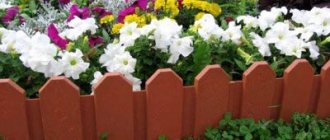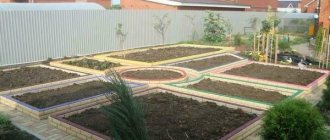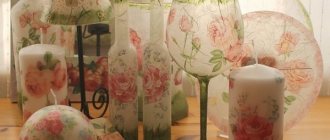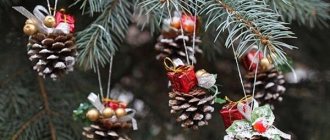If you have long dreamed of a new (or first) flowerbed at your dacha, the beginning of September is the time to make a flowerbed; perennials are usually replanted at this time. Many are stopped by the advice to carefully prepare the land to get rid of weeds - this seems to be an impossible task. But blogger Irina Chadeeva knows several secrets of a beautiful flower bed - and shares them, as well as photos of her own flower beds.
Flowerbed with daffodils, geraniums, hostas, kupena and ferns
You may think that the most important thing is to choose and buy plants, but in fact, choosing the right place, preparing the ground and removing weeds is more important.
The fact is that not all plants in our gardens live happily ever after. Some are simply essentially juveniles, although they are perennials “according to the passport”, and live 3-4 years (for example, delphinium). Others do not overwinter well and have difficulty recovering after some winters (for example, Japanese anemones). Still others simply stop liking them. Still others grow too much (for example, loosestrife or evening primrose). Fifths turn out to be painful or constantly damaged by pests (for example, aphids often appear on aconite). And conditions in the garden change - for example, where there was sun, after a few years shadow may appear.
Shady flower bed under an apple tree with ostrich, brunnera and hostas
Therefore, you just need to once and for all come to terms with the fact that a garden is a living and complex organism, each plant in it is special. And you will definitely have to replant, move, prune and divide.
But the soil in the garden remains approximately the same for many years. Yes, without treatment it acidifies and thickens, but with proper care it remains healthy and fertile for a long time. Therefore, soil preparation is the most important matter, much more important than the choice of plants.
Astilbe sprouts in early spring
Nuances of choosing fences for flower beds
Let's look at some features of fencing for flower beds, which depend on factors such as the type of flowers being planted, the exterior of the garden plot and the purpose of the fencing:
An example of a flower bed made from tires
- If you plan to visually delimit the place where flowers are planted from another area, for example, from a path or lawn, you can provide a low fence;
- When there is a possibility that flowers may be damaged by pets or dented by children, it is necessary to construct a higher fence that can prevent the undesirable consequences of a meeting with household members;
- In some cases, it is necessary to prevent the root system of flowers from growing beyond the fence, which obliges summer residents to make a fence buried in the soil to the required distance;
- Depending on the size of the crops grown behind the fence, it is necessary to select the required structural strength so that the overgrown plant does not damage the fence or break it.
Once all of the above features have been taken into account, you can proceed to further actions, namely choosing the design of the future decorative fence.
Option for decorating a fence for a flower bed with flower pots
Return to contents
Choosing suitable materials for making a fence for flower beds
As already noted, a decorative fence can be purchased in specialized stores or constructed with your own hands. Those for whom time is more valuable than money will be able to choose a ready-made structure from materials such as metal, concrete or plastic. Perhaps the most expensive fencing for flower beds will be made of metal. You can distinguish between welded metal structures and forged fences, which are superior in cost to analogues produced by welding.
Be that as it may, metal fences for flower beds are rightfully considered very reliable and durable; the only thing you need to remember is periodic maintenance, which includes coating the fence with special protective compounds.
Metal is a material susceptible to corrosion, therefore, without proper care, all its strength qualities can be negated. Plastic fences are becoming increasingly popular among residents of country houses.
You can easily find a suitable color on the market, which will be very useful in creating a harmonious exterior. The shapes of plastic fences are varied, as are their sizes, so this type of fencing can be used to decorate not only a small flower bed, but also an impressive front garden, or even an entire plot. In operation, such fencing is very undemanding and retains its original appearance for a very long time. They are not afraid of either the hot summer sun or severe frost; the only thing that may be required from the owners is wet cleaning.
The classic and most common fencing for decorative flower beds is, of course, a wooden fence. As practice shows, such fencing is excellent for both an economy-class dacha and an elite country house. It is worth noting that such fences are less durable compared to plastic and metal fences, however, with proper care, a wooden flowerbed fence will last quite a long time.
An example of a wooden fence for a flower bed
To extend the “life” of fences of this type, it is necessary to provide treatment with antiseptic compounds that prevent rotting.
Among other things, it is necessary to note the high flexibility of wood for DIY installation work. This fact makes this material stand out and maintains its popularity. Recently, in summer cottages one can observe a very unusual picture - concrete fences. It’s much more common to see them fencing factories and construction sites. However, currently the construction market offers us decorative concrete products that can outshine other types of fencing in their beauty. Without any problems, you can choose a fence suitable for your dacha by choosing different patterns and colors.
Return to contents
Fences for flower beds: universal options (21 photos)
Flower beds often play a leading role in creating landscape design. Sometimes a small flower garden is enough to give the area some mood and bright colors. Moreover, fencing, which can be compared to a frame for an artistic painting, is important in creating a non-standard, memorable flower garden.
A border is a fence that separates a garden bed from a path or a decorative fence for a flower bed.
Functional purpose of garden fences:
- decorative – giving the flowerbed a finished and well-groomed look. A border built from a textured material that matches the exterior of the house gives the site a harmonious appearance;
- protect weaving flowerbed plants from unnecessary growth;
- formation of separate areas for different plants (plastic borders for beds). A decorative border maintains order and allows you to avoid confusion with the places where flowers are planted;
- helps to form multi-stage terraces for high flower beds so that water does not flow down;
- prevents soil from being washed out of the flower bed/bed onto the path during rainy times. It is a barrier to the penetration of sand or pebbles from the path into the flower bed/bed;
- a visual warning for small children and animals not to enter the fenced area.
Thanks to modern technologies, non-boring designers and lazy summer residents/homeowners, both traditional and creative/unusual materials are used for fencing flower beds.
Border materials
To create fences, you can use ready-made plastic elements sold in stores and construction markets. A great idea is to independently recreate a non-standard decorative fence for flower beds of any shape or height. Moreover, what material (natural or plastic) to use is determined personally by the owner of the site.
Types of wooden fencing, their advantages and disadvantages
Fences made from natural wood look great on areas. It's quite easy to make wooden borders for flower beds with your own hands.
Fences woven from wicker or reeds will give the garden an openwork mood. To arrange the structure, pegs of the same length are driven into the ground at the same distance from each other (determined by the approximate length of the twigs). By alternately braiding the pegs with twigs, you create fencing walls for flower beds with your own hands. From small round wickerwork you can make borders in the form of baskets of different diameters, and it will be interesting to place square/rectangular structures on one line like flower stands.
Advantages of wattle fence: environmentally friendly natural material is used, the shape of the flower bed or the length of the fence can be very diverse, the material is free. Disadvantages: short service life (untreated wood will quickly dry out and lose its shape).
A decorative border for flower beds in the form of a palisade is constructed from logs from 15 cm to 50 cm long. The height of the blanks depends on the diameter of the tree (the thinner the tree, the shorter the log), the parameters of the site (it looks harmonious if a large area is fenced with thick logs). It is advisable to first clear the tree of bark and treat it with appropriate protective primers. Thin pieces are sharpened on one side and driven into the ground with a wooden mallet. Thick logs are dug into the ground, and the depth of burial is determined individually.
A similar border is good for decorating country paths and flower beds near open areas. It is recommended to coat the logs with colorless varnish rather than paint in order to preserve the natural beauty of the wooden texture.
Advantages: the ability to create smooth, stepped fencing lines for flower beds with your own hands (if you dig in logs to different depths), environmental friendliness of the material, inexpensive cost, work does not require special skills or special tools. The disadvantage is that a wooden fence will not be disassembled quickly, so it is recommended to carefully plan the placement of flower beds and paths on the site.
The naturalness of wooden barriers pleases the eye and allows you to fully enjoy the fascinating pattern of wood texture.
Iron fences
Metal fences for flower beds certainly look original and stylish, urban.
Forged and welded products are created from metal. Forged items give the areas sophistication and weightlessness. Since fencing can be made to order, a design/ornament of any style can be selected. If the house already has forged elements (balcony railings, window bars), then it would be a great idea to repeat their pattern on the flower bed fences. This will create a single harmonious mood throughout the entire area.
Custom forging is quite expensive, so you can install welded fences for flower beds and beds - quite a budget option.
Advantages: durability, do not suffer from precipitation, simple installation, no foundation required for installation. Disadvantages: high price of forged products.
Decorative concrete borders
Concrete fences for flower beds are ready-made products. When choosing a suitable model, you only need to decide on the type, shape, and size. Construction and country stores offer separate fences of different geometric shapes, which are installed directly on the ground (you must first make a small depression in the ground in the shape of the curb). Garden fences with bottoms (in the form of bowls) are placed on a concrete base/mortar.
Advantages: no special care required, tolerate temperature/humidity changes well, durable. Disadvantages: “sad” appearance. To make the product attractive, it must be additionally decorated, at least painted.
Plastic dividing curbs
This is a very popular and budget option for beautifying summer cottages and garden plots. Plastic fencing for flower beds amazes with its variety of shades, shapes, and styles. For the arrangement of borders the following are proposed:
- a flexible border tape that performs more of a demarcation function as a fence for beds and flower beds than a decorative one. Sold in rolls of different lengths, widths from 10 cm to 30 cm. The surface can be smooth or wavy. The strip is dug into the ground to the required depth;
- Ready-made sectional fences and fencing for flower beds are very diverse in color and decor. At the edges of each section there are special legs that are pressed into the ground for fixation.
Advantages: low price, maintenance-free, many manufacturers, wide range of plastic borders, easy to install/remove. Disadvantage: short service life, sensitivity to temperature fluctuations, fragility of enclosing sectional products.
Brickwork as an interesting decor for flower beds
Although brick is used as the main material in construction, it is also very often used to create decorative fencing for flower beds with your own hands. Moreover, for mini-buildings you can use both old brick (from collapsed masonry) and new one. Old products used to be decorated with whitewash. Today, facing material is used to decorate garden borders. Borders for flower beds made of bricks can be laid “dry” - without fixing mixtures. But it is more practical and reliable to build a flower bed on a concrete base and fasten the masonry with cement mortar. If the flower beds are decorated with the same brick as the cladding of the house, then a harmonious composition of the site is created.
Advantages: durability, no maintenance required, many options for decorative masonry and creating borders of various thicknesses/heights, resistance to temperature changes, humidity, ability to use both new and old facing/building materials. Disadvantages: difficult to dismantle (therefore, it is advisable to accurately mark the place where the flowerbed will look colorful).
How to make a border for a flower bed with your own hands from stone?
Beautiful stone fences for flower beds will decorate any area. If formwork is not used during construction, the vertical surface will retain its textured “torn” edge. Since the masonry is fixed with cement mortar and remains for many years, you should carefully choose the location of the flowerbed, its shape, and the height of the fence.
Materials for work: any stones (pebbles, sandstone, limestone), polyethylene/roofing felt, rope with pegs, cement mortar.
The working process:
- using ropes and pegs, the markings are fixed on the ground;
- a trench is prepared for the foundation with a depth of up to 20 cm and a selected width;
- the bottom of the recess is covered with a strip of polyethylene or roofing felt;
- pour cement mortar and leave until completely dry;
- The first layer of the border is laid from the largest stones. To ensure that the stones are firmly fixed, in addition to cement, you can add earth;
- subsequent levels of stones are held together only with cement. The height of the masonry is selected individually;
- In the lower part of the fence (at ground level), ventilation holes must be formed to drain excess water from the flower beds. In order not to create unsightly holes, it is enough not to seal some seams in the masonry with mortar.
The peculiarity of a stone fence is to preserve naturalness and naturalness, no matter what additional decorations or construction techniques are used.
It doesn’t matter what the borders for beds and flower beds are made of, because any textures and shapes give the flower beds a unique look and form the uniqueness of the landscape design.
roomplan.ru
DIY flowerbed fencing
Summer residents who like to do DIY construction on their property have probably more than once come up with the idea of creating a fence from scrap materials that will make the plot unique and will not allow them to empty their pockets.
The process of installing a fence made of logs
From scrap materials on the site, a thrifty owner may have a lot of building materials, as well as items that at first glance are not at all suitable for construction. For example, the same wood, plastic or metal can be useful when building a decorative fence with your own hands. Let's try to understand the design of such fences. Return to contents
Wicker fences
Wicker flower beds and fences for the garden fit organically into the rustic style, and the plants in such flower beds look especially cute. The work itself of creating a wicker fence with your own hands will bring a lot of pleasure. To work you will need any flexible branches:
- and you;
- hazel;
- willows;
- grape vines;
- raspberries;
- cherries.
An example of a wicker fence for a summer house
It is best to prepare material for wicker flower beds in early spring; at this time, the rods have good flexibility and are better cleared of bark. If the branches are not flexible enough, they are soaked in hot water.
Return to contents
Wicker fence installation
- Along the perimeter of the fence, stakes of the required height and the same diameter are driven in. In order for the fence to be more durable, the distance between the supports should not be too large.
- The branches go around the pegs in alternation: if one pole is braided from the outside, then the next one is braided from the inside. It is better to weave from the end of the fence where the beginning of the work will be less noticeable. Weaving the second row is done in reverse; if the column is braided on the outside, the next branch should be on the inside. Each row is tapped with a hammer.
The process of making a section of wicker fence
- The branches at the ends of the fence are nailed to the supports with small nails. The lower and upper branches are tied to the supports with wire for reliability. This way the lower rod will not fall down and the upper rod will not jump out of the fence.
Tip: when weaving, you can take branches one at a time or several at a time. Very thin branches are often woven into bunches to create a beautiful chess pattern.
Wicker fences for flowers can be made in the form of a border, a fairly high fence, or in the shape of a basket. You can make a raised flower bed out of wattle fence. To do this, the sides of the flowerbed need to be protected with plastic film, drainage in the form of crushed stone and sand should be placed on the bottom and soil should be poured.
Return to contents
Wooden fence
To construct a fence of this type, ordinary boards, beams or even crooked branches can be used. Most often, familiar boards are used, which, if desired, can be shortened or made longer, and also painted in the desired color. To install it yourself, you need to calculate the number of pillars and boards that will be needed in the future. First, pillars are dug in around the front garden, after which boards are attached to them. As you can see, the manufacturing procedure is quite simple and does not require special construction skills from the summer resident.
You can often find unattended logs left over from construction on a personal plot. A fence for a flower bed can also be made from scrap materials. To do this, the material should be cut into separate parts of the required length and dug along the perimeter of the front garden.
The fence can be made the same height along the entire border of the flowerbed, or it can be of different heights, which will give the area an unusual look.
Willow twigs are often used to build fences for flower beds. Such wicker fences look great in rustic-style areas. Let's consider the technology for creating such a design. Before installation, you need to buy or collect willow twigs, since these trees are not uncommon in our country. First, you need to dig stakes around the perimeter of the flowerbed, which will serve as the base of the fence; The smaller the distance between them, the stronger the structure will be.
Arrangement of a fence for a flower bed from twigs
It is necessary to weave branches around the pegs in a checkerboard pattern, moving them back and forth: this arrangement will allow them to hold securely on the base.
Another type of fencing made from scrap materials is a fence made from fallen branches or snags. This design for a flower bed will look very natural and will fit perfectly into an area with wooden buildings. In order to build such a fence, it is enough to dig them into the ground to an impressive depth, then the fence will turn out to be quite strong.
Whatever wooden fence you choose, you must remember that this material is susceptible to the influence of the external environment and insects. This fact obliges summer residents to treat wooden structures with special protective compounds.
Return to contents
Decorative fences and fences for flower beds: the best ideas
It is impossible to imagine a summer cottage or garden plot without flowering flower beds. After all, this is the main element of landscape decoration.
But even the most beautiful flowers need a decent frame.
And here you can’t do without decorative fences or fences.
Fences for flower beds - functional and beautiful
Decorative fences for flower beds play not only a decorative, but also a practical role:
- protect plants from domestic animals;
- help divide the site into zones;
- thanks to them, the territory looks neater and more well-groomed;
- do not allow plant roots to grow beyond the flower bed;
- create a unified style of the site.
A good choice for country flower beds would be garden flowers that bloom all summer - the best perennials and annuals are discussed in the article on our website.
Original hand-made borders will help give your flowerbed a beautiful, finished look. What types of borders can you create on your own site?
Types of fencing
Currently, in stores you can find a huge variety of plastic, metal and wooden borders, fences and fences of different colors and shapes:
- Fences made from individual plastic sections are small in height and can be of different colors and shapes. They have molded legs that help keep the fence in the ground.
- The border for the flower bed in the form of a continuous flexible plastic tape in a roll is almost completely buried in the ground. With its help, you can create a flowerbed of any shape.
- Forged metal fences look great in any composition; they are ideal for open front gardens and flower beds.
- Concrete fences can withstand sudden changes in temperature, are resistant to unfavorable environments, and tolerate excessive humidity well. They come in the form of decorative borders of different sizes and shapes. Frames and individual sections are also made from concrete, allowing you to create multi-level compositions.
- Wooden fences are considered a classic option for fencing flower beds. They fit seamlessly into rustic, modern or classic landscapes.
Despite the variety of ready-made fences, they all have one significant drawback - a rather high price.
Therefore, if you lack finances and have skillful hands, you can create original fences for flower beds and flower beds from any available materials with your own hands.
The video shows ready-made decorative fencing for flower beds, made by yourself.
Choosing a fence for a flower garden
When choosing how to fence a flowerbed, you need to determine the purpose of the structure. The fence, which will simply separate flower beds from lawns or paths, may be low.
If the fence is expected to protect plants from pets, it is better to make it taller (about 40 cm) and use wood or metal. Plastic is not suitable for these purposes.
In flower beds raised above the ground, fencing should help strengthen the soil and prevent it from crumbling. Plastic structures are also not suitable here. For such flower beds it is better to use concrete, stone or metal.
Flower bed fencing can help solve another problem - preventing the roots of perennial plants, such as ferns, from spreading.
In this case, a rolled plastic border is ideal, which should be buried in the ground to 2/3 of its height.
It is also necessary to take into account the style in which the site is decorated. So, a fence made of plastic bottles will look ridiculous in a classic style. And graceful forged fences are in country style.
Fence made of plastic bottles
Plastic bottles are a material available to any summer resident. You can use them to make a fence around your flowerbed with your own hands. It is enough just to select bottles of the same shape, size and color, fill them with small pebbles or sand and close the lids.
Then you need to dig the plastic blanks along the edge of the flower bed with their necks down.
If the required number of bottles of the same color is not found, the finished fence can be painted. The same border can be made from glass bottles.
How to make a fence for a flower bed from plastic bottles with your own hands:
Wooden structures
A wooden fence for a flower bed can be made in several ways:
- A fence made of driftwood looks very unusual. Making it is quite simple - you need to find several dry thick branches or thin trunks, remove the bark from them, treat them with some means that prevent rotting, and lay them out around the perimeter of the future flower bed. After this, add soil and plant your favorite flowers.
- A log fence has an attractive appearance and will please the eye for a long time. To make it, you need to prepare the required number of logs of approximately the same height and thickness. Along the perimeter of the flower bed, remove a strip of turf and dig a small groove. Insert wooden blanks into it, tightly next to each other, fill their lower part with soil and compact them well. In the same way, a palisade is made from low pegs.
- Wicker fencing is suitable for a country-style area. In order to make it, you will need fresh willow twigs and wooden pegs.
Decorative fence made of logs
Sequence of actions in the latter case:
- first you need to dig pegs around the flowerbed;
- then take a twig and start braiding from the wrong side;
- the pegs should be braided in a checkerboard pattern;
- so that the branches fit more tightly to each other, they need to be tapped with a hammer;
- the ends of the rods must be secured to pegs using nails.
Brick fence
If there are bricks left after building a house, they can make a cute and, at the same time, easy-to-make flower border. The easiest way is to lay the bricks flat around the flowerbed.
You can do it another way - remove the top layer of earth, pour sand into the resulting groove and compact it tightly. Then build a wall of bricks placed on the short side, cover it with earth and compact it well again.
Instead of sand, you can use cement mortar.
The photo shows a simple decorative brick fence
Natural stone - unusual and functional
In addition to bricks, you can also use natural stones. After all, they are found almost everywhere - in the field, in the garden or at the edge of the forest.
It’s enough to simply make a border from large boulders - remove the turf around the flowerbed and lay them close to each other. The bottom of the stones should be covered with earth.
If you need a higher fence, it is better to choose flat stones. The first row is laid out on a concrete pad, and all the rest are laid using concrete mortar, to which (for strength) you can add special glue for exterior use.
Stone fencing
In recent years, fences made of luminous stones have become very popular.
To make such a decorative fence with your own hands, you need to cover the pebbles with luminescent paint, which will accumulate energy during the day, and in the evening all the flower beds will be surrounded by a mysterious light.
A very beautiful fence around a flower bed can be created from multi-colored pebbles:
- first you should arrange the pebbles by color and come up with a mosaic pattern;
- then it is necessary to remove the layer of soil at the site of the future fence, fill the ditch with sand and gravel, compact them well;
- make formwork and pour concrete mortar;
- When the concrete begins to harden, lay out pebbles.
Instead of pebbles, pieces of ceramic tiles, dishes, glass fragments or shells are also used.
Rope fence
Using a rope or string you can make a unique fence. It is made without the use of special tools.
It is necessary to place wooden posts with holes drilled in them around the perimeter of the flower bed and stretch the rope, lowering it slightly.
Unusual uses for ordinary things
Almost every home has unwanted or damaged CDs. But few people know that they can make an excellent fence for a flower bed.
You need to tie the disks one to the other in a chain (no more than 6 pieces in each) and attach them to pegs dug along the edge of the flowerbed. You can make a fence either in one or in 2-3 rows. Such a fence will sparkle beautifully in the sun, attracting the attention of passers-by. Car tires are often used to make flower garden fences.
They are painted in a variety of bright colors, then dug in vertically or laid flat. Several tires laid one on top of the other make an excellent multi-tiered flower bed.
How to make fences for flower beds from tires?
Old furniture and plumbing - unusual and interesting
Eye-catching surrounds can be made from old furniture and fixtures, such as beds, dresser drawers, bathtubs and vanities. They are dug into the ground, covered with nutritious soil and flowers are planted. Old boats or carts are also used.
Fence for a flower bed from the bathroom
An original border can be made from unnecessary plates, placing them on an edge along the perimeter of the flowerbed. The main thing is to choose dishes according to color and size.
Each type of fencing has both pros and cons. However, even the most modest and easy-to-make fence can make a flower bed attractive. And making decorative fences for flower beds with your own hands is not so difficult. The main thing is imagination and patience.
1decor.org
Brick or stone fence
For a stone fence you will need stones of various sizes, which are laid out in a chaotic manner around the flower bed. To prevent the fence from falling apart over time, individual elements should be secured with cement. Stone fences can be either high or low, however, structures no higher than 20 centimeters are usually erected for flower beds.
If brick was chosen as the material for building the fence, DIY installation will be much easier. The structure can be erected using conventional masonry, or brick blocks can be laid on edge. The brick can later be painted in the desired color to give the area a harmonious look. Naturally, such a brick fence will cost more than its wooden counterparts, however, if there are unnecessary old bricks lying around on the site, then the construction will cost the summer resident almost free.
Return to contents
Fence made from scrap materials
Often, owners of country houses use materials to improve their plots that, at first glance, have nothing to do with construction, and fences for flower beds are no exception. Let's consider the most popular means with which you can make a decorative fence. One of the most popular fencing made from scrap materials is a fence made from old car tires. The tires are dug halfway into the ground, and the part protruding above the ground is painted in the desired color.
An example of a flowerbed made from tires
Some handymen manage to make all sorts of figures from tires, for example, swans, and decorate flowerbeds in this way.
In any case, such a design will not go unnoticed. A more unusual way to decorate a flower garden is to use old CDs. For such a fence, you will need to dig supporting stakes into the ground, on which the music discs will be attached. This arrangement of flowers will constantly sparkle in the sun, attracting the eyes of others to you and the flowers.
The easiest thing to do with your own hands is a fence made from glass or plastic bottles. All summer residents will have this material, so there shouldn’t be any problems finding it. To build a fence for a flower bed, you need to dig the bottles, neck down, to the same depth. It is best if the bottles are the same color. There are many more ways to make fences from scrap materials, and in order to come up with your own method, you just need to take a good look at your feet. Maybe there is something lying around your site that seems like it’s time to throw it away, but after reading this material, you will look at these things with different eyes.











